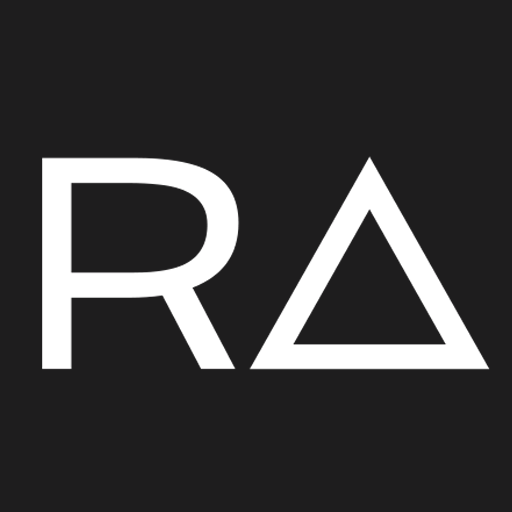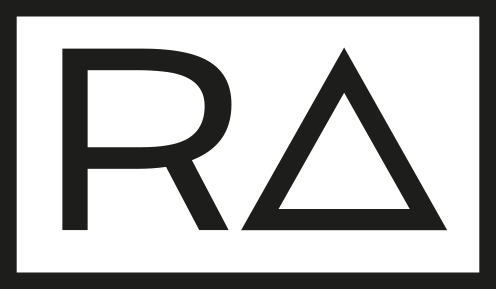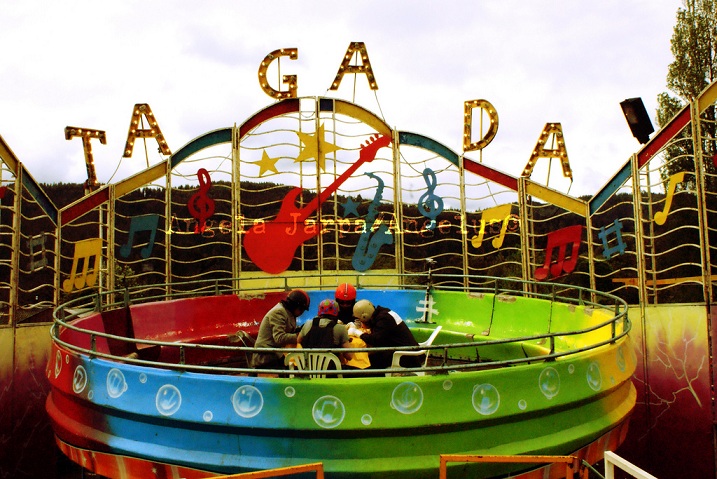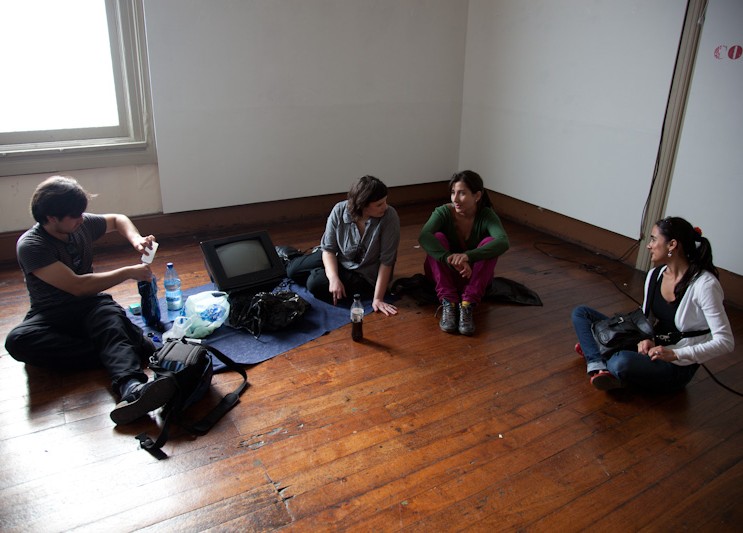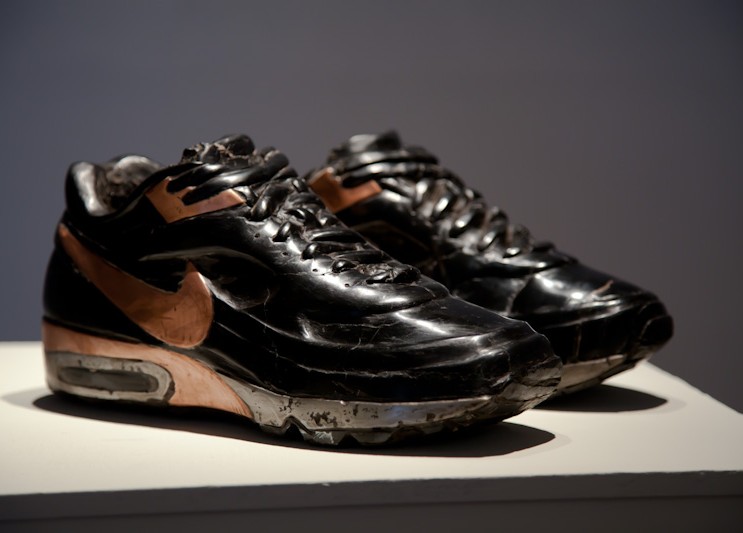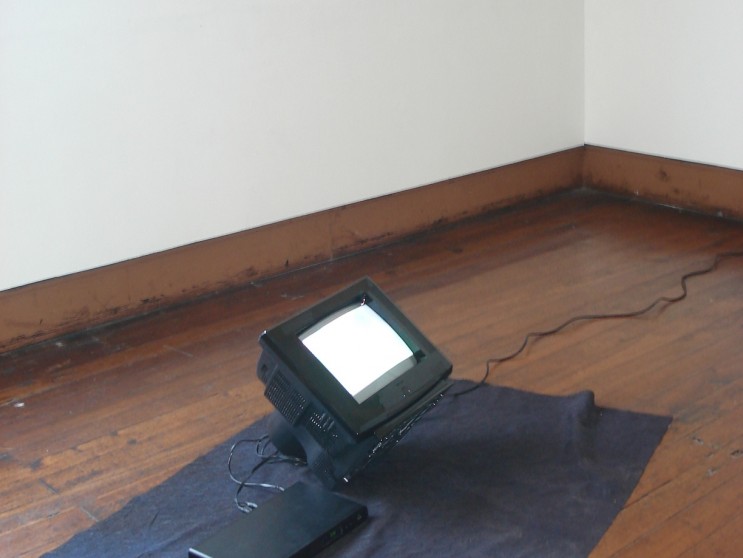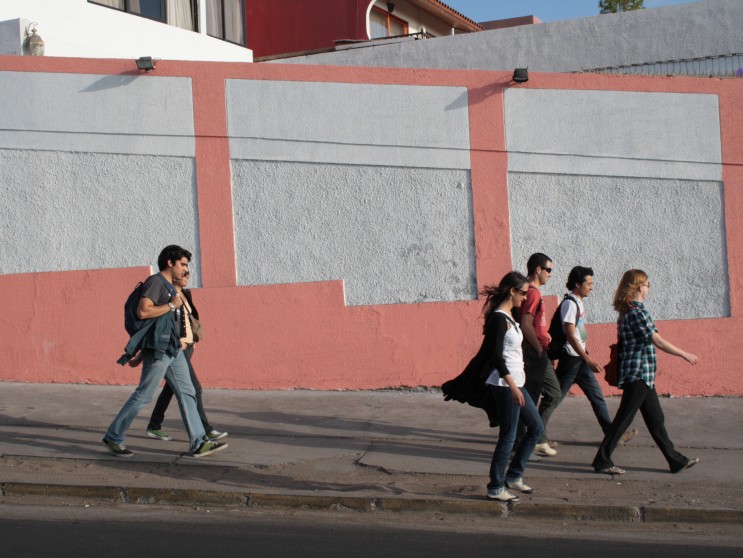Placing the reality that the visual arts(1) undergo today and, at the same time, connecting them with actions for the promotion of contemporary art from the Tarapacá Region in Chile, are part of the focal points of the project entitled Transcripcion_Local.
Transcripcion_Local is a contemporary art project that has exhibited the works of visual artists(2) from four South American countries: Argentina, Colombia, Peru and Chile. The selection arises mainly from the constant effort of these artists to expand their research area and also their interest to develop and display their artwork in cities and regions, without structures or operating schemes for the growth of these artistic practices(3).
But, how can we facilitate in Transcripcion_Local, the sense of autonomy by which the art must be mobilized in the absence of spaces and discourses that generate analysis?. Or, facing this, how can we continue to argue that museums, cultural centers or malls are the endowed entities to validate processes of artistic creation?. That is, would the absence of museums or cultural centers in Northern Chile be an obstacle for spreading contemporary art?
The experience of Transcripcion_Local validates the arguments on the visibility that contemporary art must establish, and up to this point, the construction of projects to maintain these objections. In part we know that when we have drawn a project for the spread of contemporary art, we are summarizing the vision with which some institutions and experts have already worked. However, in most cases the information of that vision is not shared or not widely known. Therefore, the organization of these experiences and the work presented by the artists through their problems and questions, would open options to encourage projects of this kind in different locations.
As for its operation, Transcripcion_Local has developed through conferences, residencies, workshops, clinics and research labs on local stories that deal with contemporary art. Therefore, these actions set and relate sources of reflection, for example with the aim to protect the editorial work done and to be done in Chile and elsewhere in South America.
In addition, and not least important, Transcripcion_Local has strengthened education media in schools, colleges and future exhibition spaces that are currently being built in the region. For this reason, the curatorial action of Transcripcion_Local has proposed to explore a transdisciplinary laboratory model, together with the dualities between artist-territory and work-place, establishing a direct contact with the concepts of territory, archive and networking.
Why territory? This is because in the construction of its own self, in a constant Heideggerian challenge, human beings construct their identity according to a matrix of relationships among which the bonding strength of the territory stands out. Belonging to a place, being recognized in a given venue, derives from the territorial nature of the human animal(4). But, at the same time, it is the way that the territory assumes the space and encourages political and intellectual reflection.
The actions proposed by contemporary art in Northern Chile have made difficult to promote the “cultural” collection that would be found in the archives. Thus, confirming that the archives have been detached from the artwork. If we do not have the ability to extend the concept of archive, we will continue to think of it as a place with shelves full of books and papers. The archive must undertake other functions, it must be museum, be art gallery, it has to document and promote the actions of the artists, being them individual or collective. This is the way an information transfer is provided and that transfer also means archive work. The characteristics of the archive generate basic judgment on the research work of contemporary art projects. In this way, the archive factor is paramount to increase the building of strong visual arts activities and assist in the projection and continuity of the same processes of creation and documentation.
All effects that our thinking could cause on territory and archive, should not be alien to the subject that generates the interconnection provided by the participating artists from different countries and cities of the Southern Cone. From Iquique, these networks heavily engaged by their economic character, are equivalent to a cultural fabric. Indeed, it is an action that has risen to the same demand from local governments of neighboring countries, strongly attracted by the Free Trade Zone.
The first step of Transcripcion_Local was to gather around a table invited visual artists, arts managers and critics from different research areas, in the CREAR Archive(5), to talk about the major issues prevailing today in the world of visual arts, including creation and promotion. The experience exposed the critical judgments we have about the feasibility of developing the ‘scene’ versus the contemporary art plans. After the meeting and similarly to a scientific survey of the territory, Transcripcion_local considered the modality of visiting certain emblems of the territory, including the Pisagua cemetery walk and an inspection to an abandoned newspaper and periodicals library. Thus, the traces of what must be filed and documented, the production of an exhibition and, finally, the construction of networks among regions have reformulated part of the place where the artwork intensifies.
During these discussions it was timely to listen to Carlos Flores Delpino (6) with his theory of the sly and eccentrics (7) and include, as an example, the role played by the insertion of Chilean cinema in the process of the artistic creation in the past ten years. But Flores Delpino was not alone, Justo Pastor Mellado (8) and Bernardo Guerrero (9) were also part of this conversation. Each of them contributed to the discussion from their own trenches. Justo Pastor Mellado who has worked and studied the local scenes in various places in Chile, had to saturate himself with the uniqueness of the creators and their works in a vacant space, one that has de-structured the political affiliation of the people and the very institutions that have been responsible for promoting and financing contemporary art in Chile. On the other hand, from his research, Bernardo Guerrero has created an archive, compiled in more than twenty books on Iquique and its environment. An archive that simplifies the research processes by trying to reinforce a critical mass across the document either historical, sociological, anthropological, ethnographic and even artistic.
One might also add that as question and inquiry Transcripcion_Local has seduced both the work (translation) and its analysis (interpretation). For that reason, in my curatorial work (and the work of many others) I specifically do not delimit the artistic creation (10), but rather invoke the artist to question his/her project about the territory and place. And this because territory and place cannot be separated from the creative action in the pursuit of the concept of work of art.
In Chile the dynamics that work with contemporary art are used to be established through connectors (11) that build and develop their potential spread. Here, the artists have identified what the area is and where the place is, in a laboratory empirical experience. In that sense, to ever conclude Transcripcion_local, the curatorial plot has intercepted the artists’ research processes.
To sum up, territory, archive and interconnection have merged a curatorial scheme and an unquestionable artistic disposition which is certainly active and promotes the national artistic creation, it coordinates archives and increases support networks with neighboring countries.
Situar la realidad que experimenta una escena de artes visuales[1] y, al mismo tiempo, conectarla con acciones que pretenden difundir el arte contemporáneo, desde la región de Tarapacá, son parte de los ejes principales que ha ejecutado el proyecto denominado Transcripcion_Local.
Transcripcion_Local es un proyecto de arte contemporáneo que ha exhibido las obras de artistas visuales[2] provenientes de 4 países sudamericanos como Argentina, Colombia, Perú y Chile. Principalmente su elección nace del constante trabajo de ellos por ampliar su territorio de investigación, así como también, el interés por desarrollar y exponer su trabajo artístico en ciudades y regiones sin estructuras ni esquemas operativos para esas prácticas artisticas[3].
Pero en Transcripcion_Local, cómo podemos facilitar el sentido de disposición autónoma con la que debe ser movilizado el arte ante la carencia de esos espacios que automatizan discursos y análisis. O simplemente frente a esto, continuar argumentando que los museos, centros culturales o galerías comerciales son las únicas que impondrán procesos de creación artística. Es decir ¿sin museos ni centros culturales sería difícil hablar de difusión del arte contemporáneo en ciudades como Iquique?
La experiencia de Transcripcion_Local valida argumentos sobre la visibilidad que debe presentar el arte contemporáneo y, a estas alturas, la construcción de proyectos que mantengan estas objeciones. En parte ya sabemos que cuando hemos creado un proyecto de difusión de arte contemporáneo estamos recapitulando la visión con la que algunas instituciones y expertos han trabajado. A pesar de que en la mayoría de los casos la información de esa visión no es compartida ni menos conocida por todos. Por eso a través de la organización de estas experiencias y junto al trabajo que presentan los artistas a través de sus problemáticas e interrogantes son opciones que incentivarían proyectos de este tipo en distintos lugares.
En cuanto a su operatividad, Transcripcion_Local se ha desarrollado a través de coloquios, residencias, seminarios, clínicas y laboratorios de investigación de esas historias locales frente al arte actual. Por consiguiente, estas acciones establecen y concatenan fuentes de reflexión, por ejemplo para resguardar el trabajo editorial realizado –y por realizar- en Chile y en otros lugares de Sudamérica.
Además y, no menos importante, Transcripcion_Local ha reforzado los soportes educativos en colegios, liceos y futuros espacios de exhibición que actualmente están siendo construidos en la región. Por eso la acción curatorial que Transcripcion_Local me ha propuesto es la de explorar un modelo de laboratorio transdisciplinario junto a las dualidades existentes entre territorio-artista y lugar-obra, estableciendo un contacto directo con los conceptos de: territorio, archivo e interconexión.
¿Por qué territorio? Y esto porque en la construcción de su propio ser, en ese permanente desafío heideggeriano, el ser humano construye su identidad apelando a una matriz de relaciones entre las cuales destaca por su fuerza la vinculación del territorio. El ser de un lugar, el reconocerse en el lugar, es una derivación del carácter territorial del animal humano[4]. Pero al mismo tiempo cómo ese capital territorial asume el espacio e incentiva su reflexión política e intelectual.
Con las acciones que ha propuesto el arte contemporáneo en el norte de Chile ha sido difícil fomentar ese acopio “cultural” encontrado en los archivos. De esta manera, se ratifica que los archivos han estado poco familiarizados con el trabajo artístico. Si aún no tenemos la capacidad de ampliar el concepto de archivo, continuaremos pensando en éste como un lugar que solo posee estantes llenos de libros y papeles. El archivo debe tomar otras funciones, debe ser museo, galería de arte, documentar y difundir las acciones de los artistas, ya sean individuales o colectivas. Es así como se procura un traspaso de información y que ese traspaso también signifique el mismo trabajo de archivo. Las características propias del archivo generan, en el o los proyectos de arte contemporáneo, un juicio elemental del trabajo de investigación. De esta manera el factor archivo es vital para incrementar la construcción de sólidas acciones de artes visuales y colaborar en la proyección –continuidad- de esos mismos procesos de creación y documentación.
Todos los efectos que podría causar nuestra reflexión sobre territorio y archivo no deben estar ajenos del tema que genera esta interconexión establecida por los artistas que han participado provenientes de distintos países y ciudades del conosur. Desde Iquique estas redes fuertemente engranadas, por su carácter económico, se homologan a una trama cultural. Por cierto, una acción que se ha levantado ante la misma demanda de los gobiernos locales de los países vecinos y otros fuertemente atraídos por la Zona Franca.
El primer paso de Transcripcion_Local fue reunir en el archivo del CREAR[5] a los artistas visuales invitados, gestores culturales y críticos pertenecientes a distintas áreas de investigación que emplazaron, sobre una mesa redonda, los grandes temas que hoy imperan en el mundo de las artes visuales, entre ellos: creación y difusión. Además, todo esto mostró los juicios críticos que poseemos sobre la factibilidad del desarrollo de la ‘escena’ versus los planes del arte contemporáneo. Después de esto y similar a una inspección científica del territorio, Transcripcion_local consideró la modalidad de visitar ciertos emblemas del territorio, entre ellos, caminata al cementerio de Pisagua e inspección a una hemeroteca abandonada. Así los rastros de lo que se debe archivar y documentar, la producción de una exposición y, por último, la construcción de redes que nos interconecten con otras regiones han reformulado parte del lugar donde se intensifica la(s) obra(s).
En estas discusiones fue oportuno escuchar a Carlos Flores Delpino[6] con su teoría de los excéntricos y astutos[7] e insertar, por ejemplo, el papel que ha jugado la inscripción del cine chileno en los procesos de creación artística de los últimos 10 años. Pero Flores Delpino no estaba solo, también formaba parte de este coloquio Justo Pastor Mellado[8] y Bernardo Guerrero[9]. Cada uno de ellos aportaba a la discusión desde sus propias trincheras. Justo Pastor Mellado quien ha trabajado y analizado las escenas locales en varios lugares de Chile, tenía que impregnarse con la singularidad de los creadores y su obra, en un espacio baldío que ha desestructurado la misma filiación política de sus habitantes y de las mismas instituciones que se han encargado de promover y financiar el arte contemporáneo en Chile. Por otro lado, Bernardo Guerrero ha hecho de sus investigaciones, recopilada en más de una veintena de libros sobre Iquique y su entorno, un archivo que simplifica los procesos de investigación tratando de reforzar una masa crítica a través del documento ya sea histórico, sociológico, antropológico, etnográfico, e incluso en este caso artístico.
También se podría agregar que Transcripcion_Local ha seducido como interpelación e indagación tanto a la obra (traducción) como a su análisis (interpretación). Por lo que específicamente en mi labor curatorial (y en la de muchos otros) no delimito la creación artística[10], sino más bien invoco al artista para que interrogue a su proyecto en torno al territorio y lugar. Y esto ya que el territorio y lugar no pueden estar separados de la acción creadora bajo la búsqueda general del concepto de obra de arte.
En Chile las dinámicas con la que trabaja el arte contemporáneo ya están acostumbradas a establecerse a través de conectores[11] que construyen y elaboran su posible difusión. Aquí los artistas han identificado bajo una experiencia empírica de laboratorio cuál es el territorio y dónde esta el lugar. En este sentido, para concluir o no una Transcripcion_local, la trama curatorial ha interceptado los procesos de investigación de los artistas.
En resumen territorio, archivo e interconexión han fusionado un esquema curatorial y una incuestionable disposición artística que ciertamente activa y difunde la creación artística nacional, coordina archivos e incrementa las redes de apoyo con los países vecinos.
- En Chile desde hace unos 20 años se han fomentado la articulación de acciones que difunden a los artistas visuales en regiones. Obviamente, en algunas de estas, esas acciones se han desarrollado y cohesionado más rápido que otras; situación que a la fecha ha llevado a estudiar si es posible interpretar esas acciones como propias de una incipiente escena de artes visuales. Pero esto ha provocado que el Estado y los organismos competentes con el tema hayan actuado ante una coordinación más ligada a un servicio social, perjudicando el sentido esencial de la difusión del arte contemporáneo, la relación con una “escena” en particular y, por supuesto su estructura general.
- Alejandra Alarcón, Maricruz Alarcón, Luis Almendra, Rodrigo Araya, Julio Briones, Cristián Calderón, Renato Calderón, Vania Caro Melo, Cindy-Lia, Cintia Clara Romero, Oscar Concha, Italo Cossio, Gonzalo Cueto, Pablo Forero, Gianfranco Foschino, Rodrigo Lobos, Francisco Martínez, Milena Mollo, Claudia Müller, Jo Muñoz, Jorge Olave, Fernando Ossandón, Alejandra Prieto, Alfredo Protz, Daniel Reyes León, Pedro Rodríguez, Nicolás Rupcich, Raquel Schwartz, Cristian Segura, Alex Tancara, Nicolás Tapia, Carlos Vargas, Cristian Wenuvil, Jorge Wittwer y Dagmara Wyskiel.
- Adicionalmente a estos planteamientos se suma que los artistas cuentan con varias exposiciones en museos, centros culturales y galerías que han promovido el rol del artista visual y inserción y documentación de la(s) obra(s).
- BOISIER, Sergio en Estudios Transfronterizos año 1, número 1, pág. 51, Iquique, Chile, 2003.
- Fundación Centro de Investigación de la Realidad del Norte.
- Director Carrera de Cine y TV, Instituto de la Comunicación e Imagen (ICEI),
- Universidad de Chile
- FLORES DELPINO, Carlos, Excéntricos y Astutos: influencia de la conciencia y uso progresivo de operaciones materiales en la calidad de cuatro películas chilenas realizadas entre el 2001 y el 2006. Colección Cine 5, Facultad de Artes de la Universidad de Chile.
- Curador independiente y crítico de arte.
- Sociólogo y Director de la Fundación Crear.
- Tema candente entre los artistas visuales chilenos (menores de 35) que en la mayoría de los casos están supeditados a difundir su creación ante una pauta más parecida a programa de televisión, en la modalidad entretención, que a un formato de lo eminentemente artístico. Y esto se debe a la invasión de erróneos conceptos que han sido incorporados por algunos encargados de instituciones y centros de difusión del arte contemporáneo chileno. Estas falencias van desde el esquema de Escuela de Arte, hasta la nula comprensión del trabajo artístico en una sociedad como la nuestra.
- Universidades, Centros de Investigación, Factor fondart, entre otros.
